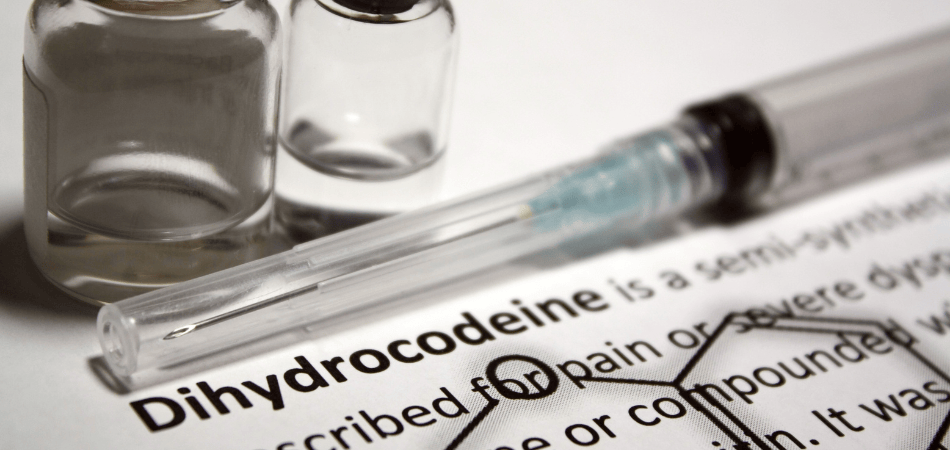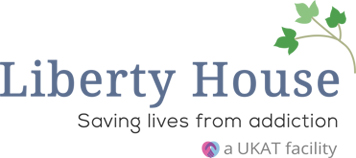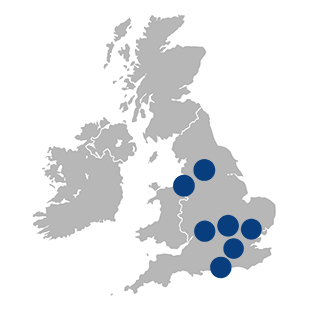Dihydrocodeine addiction
Dihydrocodeine is a prescription pain medication in the opioid family. Although dihydrocodeine can be useful in a medical setting, many people find that they develop a strong dependence on dihydrocodeine with regular use, leading to uncontrollable cravings, compulsions and addiction. The misuse of dihydrocodeine can be extremely dangerous, especially when it is consumed with other substances. A recent study found dihydrocodeine to be involved in 2,071 deaths between the years 2001 – 2020.
It is therefore vital that you seek professional help if you have found yourself unable to control the amounts of dihydrocodeine you consume. With the right support and proper treatment strategies in place, most people are able to successfully overcome their dihydrocodeine addiction.

What is dihydrocodeine?
Dihydrocodeine is a semi-synthetic analgesic opioid, similar to codeine, although probably twice as potent. It is commonly used to treat moderate to severe pain, as well as a cough suppressant. Dihydrocodeine can also be prescribed as a way to manage other opiate addictions, including heroin addiction.
Dihydrocodeine is usually taken in tablet or liquid form when prescribed. It is important to take dihydrocodeine as directed by your doctor, as anything outside of this can lead to dihydrocodeine addiction.
What is dihydrocodeine addiction?
Dihydrocodeine has a high potential for abuse and addiction. This substance attaches to opioid receptors in the brain and triggers a cascade of neurotransmitter releases that are responsible for many of the rewarding effects of dihydrocodeine use. These include feelings of euphoria, relaxation and detachment from one’s surroundings.
In addition, dihydrocodeine produces tolerance and dependence, both of which are key markers of addiction. Dihydrocodeine tolerance occurs when the body no longer responds to the drug in the same way and you must therefore take higher doses to feel the same effects. Dihydrocodeine dependence refers to the need to take the drug in order to feel ‘normal’ and experiencing dihydrocodeine withdrawal symptoms should you try to stop.
Dihydrocodeine addiction is defined by:
- The compulsive need to take dihydrocodeine
- Experiencing cravings for dihydrocodeine
- Continued use of dihydrocodeine despite any negative consequences
- Inability to control the amount or frequency in which dihydrocodeine is consumed
If you believe that you or a loved one has an addiction to dihydrocodeine, you don’t have to suffer alone. It is possible to get the treatment you need – with the appropriate resources and support, you can start to enjoy life again.
Who is at risk of developing dihydrocodeine addiction?
Dihydrocodeine addiction can affect anyone, but there are certain risk factors that can make someone more vulnerable to developing an addiction. Some of the main risk factors include:
- Genetics: studies have shown that there are specific genes that put you at a greater risk of developing a dihydrocodeine addiction. If addiction runs in your family, it could not only be a learned behaviour, but also a genetic predisposition.
- Mental health conditions: many people take dihydrocodeine as a way to self-medicate underlying mental health issues, including anxiety, depression and PTSD. However, while the effects of this drug may initially appear to ease symptoms, they will come back tenfold soon after.
- Stress: turning to dihydrocodeine as a means to cope with stress is common. You may feel like the drug’s effects help you to get by, but dihydrocodeine addiction can soon take over your life, leaving you in a vicious cycle of drug abuse and addiction.
- Trauma: experiencing a traumatic event, especially during childhood, can lead people to abuse dihydrocodeine and eventually become addicted as they attempt to escape negative thoughts surrounding their trauma.
- Exposure to drugs at a young age: studies have shown that taking drugs, including dihydrocodeine, while the brain is still maturing puts you at a higher risk of developing an addiction. This is because, firstly, you are more prone to risk-taking activities, and secondly, your brain will be more susceptible to the drug’s effects.
- Underlying medical conditions: if you are prescribed dihydrocodeine for legitimate medical purposes, you are also at risk of developing an addiction, particularly if it is being prescribed to treat an existing drug addiction. It is therefore important to follow your doctor’s instructions when taking dihydrocodeine.

It is important to be aware of these risk factors so that you can take appropriate steps to prevent dihydrocodeine addiction from forming, or get the help you need should you fall into one of these categories.
The side effects of dihydrocodeine
The effects of dihydrocodeine are potent and the abuse of this drug can cause negative consequences to your health. Some of the effects of dihydrocodeine include:
- Nausea and vomiting
- Constipation
- Fatigue
- Dizziness or feeling lightheaded
- Confusion
- Dry mouth
- Headaches
- Low blood pressure
The prolonged use of dihydrocodeine can also result in urinary tract issues, including renal colic and urinary retention.
If dihydrocodeine is taken in higher doses than prescribed or alongside other depressant substances such as alcohol, the effects on the central nervous and respiratory systems can be serious, and even deadly. In these circumstances, the risk of respiratory depression, dihydrocodeine overdose and death is increased.
How is dihydrocodeine addiction treated?
Liberty House is dedicated to your recovery from dihydrocodeine addiction and has a friendly and knowledgeable team waiting to guide you through treatment. At our centre, you will have access to a comprehensive treatment programme designed with your success in mind. Your recovery journey will begin with a dihydrocodeine detox, followed by therapy and rehabilitation and aftercare.
Dihydrocodeine detox
Detox is the first step in your recovery and is the natural process of expelling dihydrocodeine from the body in order to break your physical dependence. With this sudden cessation of use, a chemical imbalance occurs and your brain and body have to work hard to adapt to a lack of dihydrocodeine. It is because of this that you may experience some uncomfortable withdrawal symptoms.
Some dihydrocodeine withdrawal symptoms you may expect to experience include:
- Headaches
- Sweating and chills
- Nausea and vomiting
- Diarrhoea
- Dizziness
- Tremors and shakes
- Anxiety
- Irritation and mood swings
- Insomnia
- Restlessness
- Heart palpitations
- Strong cravings
It is advisable that you undergo dihydrocodeine detox under the supervision of medical professionals who can help you to manage your symptoms. It is likely that your doctor will come up with a tapering schedule so that you are able to slowly wean yourself off of dihydrocodeine and avoid any serious side effects.
The timeline of your dihydrocodeine detox may vary depending on the severity of your addiction as well as your physiology, for example, your age, general health and metabolism rate. Generally, you will see your withdrawal symptoms peak within the first three days and slowly dissipate over the course of one to two weeks.
Dihydrocodeine rehab
Dihydrocodeine rehab is a specialised treatment programme that is designed to help individuals overcome their addiction to this powerful prescription medication. During dihydrocodeine rehab, you will be able to discover the underlying causes of your drug use and learn how to manage any co-occurring mental health issues. This will leave you better equipped for handling challenges or negative emotions that may arise once you walk out of our doors.
At the heart of a successful dihydrocodeine rehab is evidence-based therapies that are shown to encourage healthier behaviours and patterns of thought – something that is vital for long-lasting sobriety.
Some of the most commonly used therapies at Liberty House include:
- 12-step programme
- Dialectical behaviour therapy (DBT)
- Group therapy
- Fellowship meetings
- Motivational interviewing
- Family therapy
- Solution-focused therapy
- Relapse prevention

At Liberty House, we strive to create a relaxing and therapeutic atmosphere that promotes healing and puts our clients’ minds at ease. You will be able to fully focus on your dihydrocodeine recovery away from the stress and triggers of daily life, eat nutritious meals, and take part in holistic activities such as art therapy, yoga and meditation.
Dihydrocodeine aftercare
Aftercare is an essential component of any successful drug rehab programme. Prescription drug addictions like dihydrocodeine addiction can be an extremely difficult and challenging condition to overcome, and it often requires sustained effort and support after initial treatment has been completed.
The purpose of aftercare is to help you maintain the progress you have made while in rehab treatment by providing ongoing support, education and guidance. At Liberty House, we understand how vital this stage of dihydrocodeine recovery is, and so we offer all of our clients one year of free aftercare, as well as access to our Alumni programme. Having a network of peers often proves invaluable in our client’s success as it provides you with moral support and accountability outside of dihydrocodeine rehab.
Tips for a successful dihydrocodeine rehab
When it comes to dihydrocodeine rehab, there are a number of things that you can do to increase your chances of a successful recovery. The first and most important step is to find a high-quality rehab facility that aligns with your needs and has experience in treating dihydrocodeine addiction.
Some other tips for a successful dihydrocodeine rehab include:
- Set realistic and attainable goals
- Build a support network around you
- Tackle each day as it comes
- Accept that some days will be better than others
- Participate in therapy and group sessions
- Eat a healthy diet and stay hydrated
- Get regular exercise
- Get enough sleep
- Keep busy with enjoyed hobbies or activities
- Stay the course – don’t leave rehab early!
By staying focused on these key points, working closely with healthcare professionals and incorporating lessons learned in therapy, you can ensure you remain on track throughout dihydrocodeine rehab and avoid any potential setbacks along the way.

